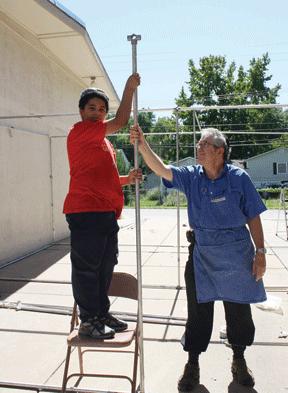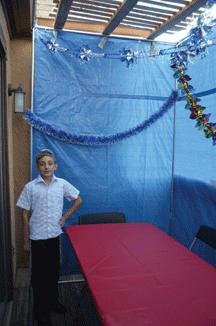
In the office or the hospital right after morning minyan and working extended hours, radiation oncologist Jay Robinow has saved hundreds of lives. That’s his day job.
{mprestriction ids="1"}Late into the night, Dr. Robinow has also saved hundreds of lives, but spiritually rather than physically. Since 2007, he has built and/or expanded more than 150 sukkot for people across the state of Kansas. Profit isn’t the motive of this sukkah venture, says the builder.
“Let’s just say this would not be a good case study for the Harvard business school,” Dr. Robinow tells JNS.org. “It’s definitely a money-losing business.”

That’s because any proceeds from Dr. Robinow’s sukkah projects go to the KC Kollel, and he also donates at least half of the sukkot and sukkah parts he has worked with. For example, Dr. Robinow often provides young couples with a sukkah during their first year living here. He buys and builds sukkot as wedding gifts and lends a hand to those who cannot afford a sukkah, such as single mothers or large Orthodox families. He also makes a habit of donating and building a few sukkot each year for less-observant families interested in exploring this Jewish ritual. More often than not, the sukkah leads the latter families to greater engagement with Judaism, and sometimes even a transformation of their observance.
“In some ways, it’s become a kiruv (Jewish outreach) initiative. But that’s not its purpose,” Dr. Robinow says.
Dr. Robinow created the design for the sukkot he builds. He orders corner pieces from an online canopy store — he says “they know me by now and all about Sukkot” — and gets the rest of the sukkah parts fashioned at the local Home Depot. Because of his day job, he works late into the evening, often as late as midnight, to get the sukkot built each year.
Dr. Robinow recalls that the year BIAV’s Rabbi Dani Rockoff moved to town, the rabbi discovered just hours before Sukkot that he was missing his personal sukkah’s corner pieces.
“When he unpacked, he didn’t have them,” says Dr. Robinow. “It was three hours until yom tov, but we started it all over. I went and bought new materials, and the sukkah was up as the holiday came in.”
Over the years, Dr. Robinow has roped his five children into the “business.” His son David, a senior at the Hyman Brand Hebrew Academy, says many times his father loads the car with the sukkah gear and drives him and his brother to an area home. Dr. Robinow unloads the materials and tells them to get to work, and returns in a couple of hours. While the boys build one sukkah, Dr. Robinow reloads the car and takes off to build another.
“For me, I’m like the shoemaker’s wife,” says wife Margie Robinow with a chuckle. “I had to beg for years to get my sukkah expanded. Finally, two years ago, he did it.”

Single mother Michal Luger says she is still in awe every time she pictures the night that Dr. Robinow drove up to her modest apartment and built her a sukkah — the first she ever had. Her son, Shai-El, was born the day before Sukkot and she had always envisioned the household celebrating the holiday in its own sukkah. But financial circumstances and the inability to erect one on her own had kept that dream from becoming a reality. Last year, the day before Shai-El’s 10th birthday, at 10 p.m., Dr. Robinow surprised her with a sukkah.
“It was really, really exciting,” says Luger, who took dozens of pictures of her son in the sukkah that night and every night of the holiday (other than Yom Tov) thereafter. “It was the most amazing thing.”
Dr. Robinow was “as tired as anyone could be,” but he built the sukkah “with the biggest smile on his face,” Luger recalls. Shai-El’s happiness was “tangible,” she says. He ate every meal in that sukkah during the holiday and invited all of his friends over for a sukkah party.
For Marsha Johnston, Dr. Robinow was her first introduction to the Kansas City-area Orthodox Jewish community.
“We just couldn’t believe Jay was so kind,” she says, noting that when he put the sukkah up seven years ago her son was dabbling with observance through the Orthodox youth group NCSY. Today, her then 14-year-old is a 22-year-old yeshiva student. But whenever he is in town, he still drags out his mattress and sleeps in Dr. Robinow’s sukkah.
Todd Natenberg and his wife received their sukkah from Dr. Robinow three years ago, just after the birth of their twin sons. Natenberg says he grew up with some Jewish traditions, such as celebrating Passover, but he had always wondered about Sukkot. Dr. Robinow came to Natenberg’s Leawood home and the two built the Natenberg sukkah together. Now, Natenberg builds the sukkah on his own every year.
“Jay is so concerned about the Jewish community,” says Natenberg. “Whether it’s by being a radiologist or helping to build sukkahs in a place like Kansas, he’s helping the world. He’s a model of Judaism, a model of what it’s all about.”
Those who visit the Jewish Community Center during Sukkot can thank Dr. Robinow for the sukkah they walk through on their way in the Fitness and Sports entrance of the facility.
“It was my gift to the JCC,” said Dr. Robinow, taking time out from building the sukkah at his congregation this past Sunday. “I designed it and built it so when you walk through the sukkah it gives people pause that Sukkot is approaching.”
He frequently builds sukkahs at the apartments just down the street from BIAV where Luger lives.
“Those are not technically sukkahs but they give people a feel for Sukkot.”
He also uses recycled sukkah parts whenever they are available.
“I’ll take an old sukkah and re-use the materials. Then I’ll build a sukkah for someone else,” he said.
Dr. Robinow remains humble about his “sukkah business.”
“People need sukkahs,” he says, surprised that anyone would be interested in his story.
Yet Robinow admits that it’s kind of fun to see his neighborhood, smack in the middle of a Kansas suburb, decked out with sukkahs. While he can’t take credit for all of them, the community knows he has played a pivotal role in its “sukkah-fication.”
“When we first moved here, there were maybe five or six [sukkahs],” says Robinow. “Now there are probably 30 or 40. It’s real simple.”
Maayan Jaffe is a freelance writer in Overland Park, Kan. Reach her at or follow her on Twitter, @MaayanJaffe.
{/mprestriction}



